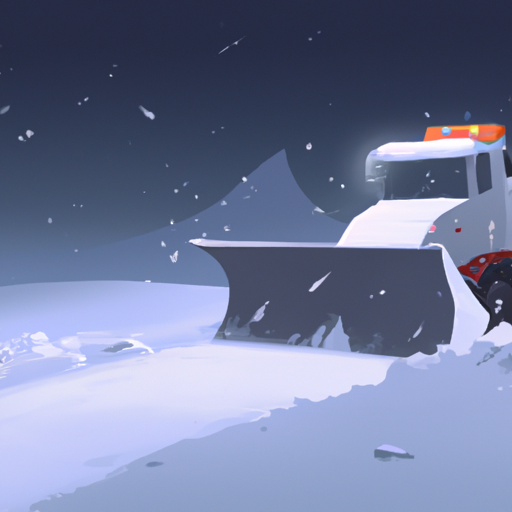Keeping roads clean and safe in all seasons can be a daunting task. This guide offers year-round maintenance tips to ensure that roadways are always at their best. From snow removal in winter to foliage cleaning in autumn, this guide covers it all, offering practical advice for all types of road cleaning challenges.
Winter Woes: How to Effectively Clear Snow and Ice?
When winter arrives, snowy and icy roads can be a major headache for both drivers and road maintenance crews. However, with the right strategies and equipment, it is possible to effectively clear snow and ice, ensuring safe and smooth travel for everyone. The first step is to have a well-planned snow removal strategy in place. This includes assigning designated routes for plowing and salting, prioritizing high-traffic areas such as highways and main roads. Regular monitoring of weather forecasts is crucial to anticipate snowstorms and take proactive measures.
In terms of equipment, having reliable snowplows and salt spreaders is essential. Snowplows with adjustable blades can efficiently clear various depths of snow, while salt spreaders help to melt ice and improve traction. It is important to maintain these machines regularly, ensuring they are in good working condition before the winter season hits. Additionally, using deicing chemicals like rock salt or calcium chloride can aid in melting ice and preventing it from forming again.
Another effective method is to use snow fences to reduce snow accumulation on roads. These fences act as barriers, trapping snow before it reaches the road surface. By strategically placing snow fences in areas where drifting snow is common, road crews can minimize the amount of snow that needs to be cleared.
Finally, it is crucial to have a dedicated and skilled workforce for snow and ice removal. Hiring experienced operators who are familiar with the equipment and techniques for clearing snow and ice can make a significant difference in the efficiency and effectiveness of road cleaning. Regular training sessions should be conducted to ensure that crews are up-to-date with the latest practices and safety protocols.
A snowplow clearing a snowy road during a heavy snowfall
Spring Cleaning: Isn't it More Than Just Clearing Debris?
Spring cleaning is not just about clearing away debris from the roads. It involves a comprehensive approach to ensure that the roads are in optimal condition after the harsh winter months. One of the main tasks during spring cleaning is repairing any damage caused by freezing temperatures and heavy snowfall. This includes fixing potholes, cracks, and other road surface imperfections that can pose a risk to drivers. Regular inspections should be conducted to identify these issues and address them promptly.
In addition to repairing damages, spring cleaning also involves thorough street sweeping to remove accumulated dirt, sand, and other debris. This not only improves the aesthetics of the roads but also helps maintain good drainage, preventing water from pooling and causing potential hazards. Street sweepers equipped with powerful brushes and high-pressure water jets are commonly used to ensure a thorough cleaning.
Spring is also the time to assess and maintain road signs and markings. Winter conditions can cause signs to become damaged or obscured, and road markings may fade or wear off. Replacing or repainting these signs and markings is crucial for ensuring clear and accurate guidance for drivers.
Furthermore, vegetation management is an important aspect of spring cleaning. Overgrown trees and bushes can obstruct visibility and create hazards for drivers. Trimming back vegetation along the roadsides allows for better visibility and reduces the risk of accidents. It is important to adhere to local regulations and guidelines when performing vegetation management to ensure the safety of workers and preserve the natural environment.
Finally, spring cleaning should include a thorough inspection of drainage systems. Melting snow and increased rainfall can put a strain on drainage infrastructure, leading to flooding and water damage. Clearing drainage ditches, culverts, and catch basins of debris and obstructions helps ensure proper water flow and prevents road damage.
"Summer heat and dust: how to keep roads clean and cool?"
During the scorching summer months, keeping roads clean and cool becomes a crucial task for road maintenance crews. The combination of intense heat and dust can create dangerous conditions for drivers. Regular sweeping and dust control measures are essential to maintain road safety and comfort. One effective method is to use street sweepers equipped with dust suppression systems. These systems use water or other dust suppressants to prevent dust particles from becoming airborne and reducing visibility. Additionally, road surfaces should be regularly sprayed with water to minimize dust accumulation and keep the temperature down.
In areas with high temperatures, road surfaces can reach extreme temperatures, making them uncomfortable and potentially damaging to vehicles. To combat this issue, road maintenance crews can apply a thin layer of cool pavement coatings. These coatings help to reflect sunlight and reduce the absorption of heat, keeping the road surface cooler and more comfortable for drivers. Regular application of cool pavement coatings can also help extend the lifespan of the road by minimizing thermal stress and cracking.
Another aspect of road maintenance in summer is the repair of any damage caused by the heat. Extreme temperatures can lead to the expansion and contraction of road surfaces, resulting in cracks and potholes. It is essential to identify and repair these issues promptly to ensure the safety of drivers and prevent further damage. Additionally, regular inspections should be conducted to identify areas of the road that may be prone to heat-related damage, allowing for proactive repairs and maintenance.
Finally, proper vegetation management is crucial during the summer to prevent overgrown trees and shrubs from obstructing the roads and reducing visibility. Trimming back vegetation along the roadsides not only improves visibility but also reduces the risk of wildfires, which can be a significant concern during dry and hot summer months.
A road being hosed down to remove dust and lower temperature during a hot summer day
Autumn Leaves: Can They Become a Road Hazard?
As the vibrant colors of autumn leaves blanket the ground, they may create a picturesque scene, but they can also become a potential road hazard. Fallen leaves can accumulate on road surfaces, leading to slippery and dangerous driving conditions. The moisture from rain or dew can cause the leaves to become slick, similar to driving on ice. This can result in reduced traction and longer braking distances, increasing the risk of accidents. Additionally, leaves can obscure road markings and traffic signs, making it difficult for drivers to navigate safely.
To mitigate the dangers posed by autumn leaves, regular road sweeping and leaf removal are essential. Street sweepers equipped with specialized leaf collection systems can effectively clear the roads of fallen leaves, reducing the risk of skidding and improving overall road safety. It is crucial to prioritize areas with high traffic volume, such as intersections and highways, where leaves can accumulate quickly and create hazardous conditions.
In addition to sweeping, road maintenance crews should also consider using leaf blowers or leaf vacuums to remove leaves from the roadside and gutters. Ensuring that drains are clear and functioning properly is important to prevent water from pooling and creating additional hazards. Proper disposal of the collected leaves is equally important to prevent them from blowing back onto the roads or clogging drainage systems.
Road Cleaning Tips:
| Season | Maintenance Tips | Tools Needed | Additional Tips |
|---|---|---|---|
| Winter | Snow removal, properly storing chemicals and salt, removing ice and slush | Snow shovels and ice scrapers | Keep an eye on the forecast for cold snaps and storms |
| Spring | Remove debris from the roadways, clean up sand and gravel, inspect and repair signs | Leaf blower, broom, shovel, traffic cones | Be mindful of wet weather for pothole repair |
| Summer | Cut grass, trim vegetation, clean up debris, inspect signs and markings | Lawnmower, trimmers, paint, traffic cones | Be aware of extreme heat for asphalt repair |
| Autumn | Clear fallen leaves, inspect signs and markings, repair potholes and cracks | Leaf blower, broom, shovel, traffic cones | Be aware of wet weather for foliage cleaning |
Year-round road cleaning and maintenance is a demanding task, but with these tips, you can ensure that your roadways are safe and clean no matter the season. Whether it's removing snow in winter or dealing with heavy foliage in autumn, there's always a strategy to keep your roads in top shape. Remember, a clean road is a safe road.



